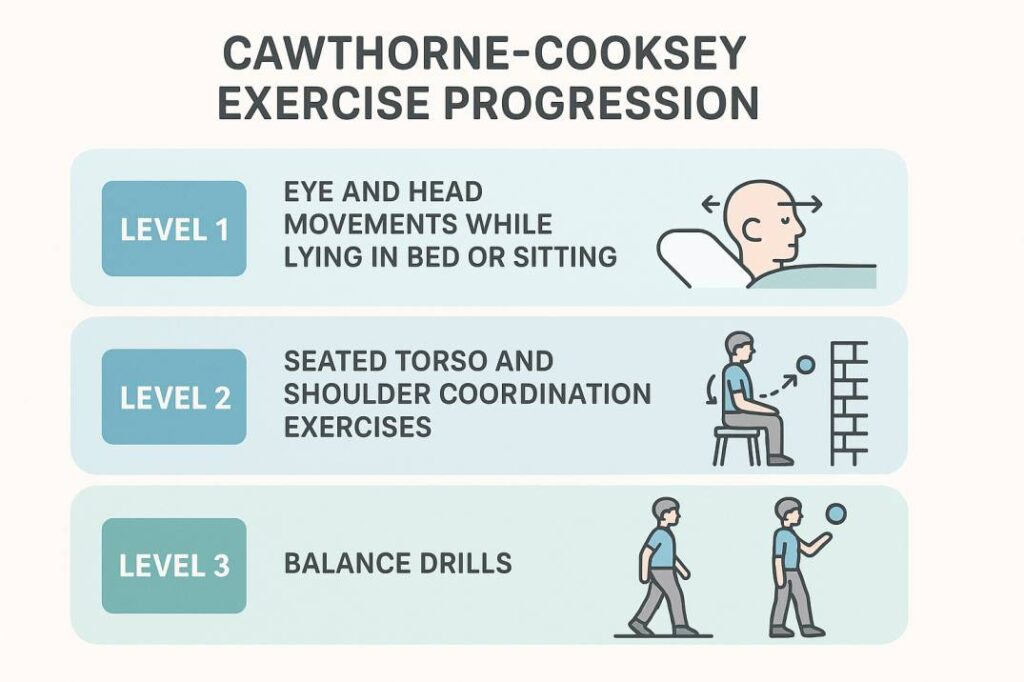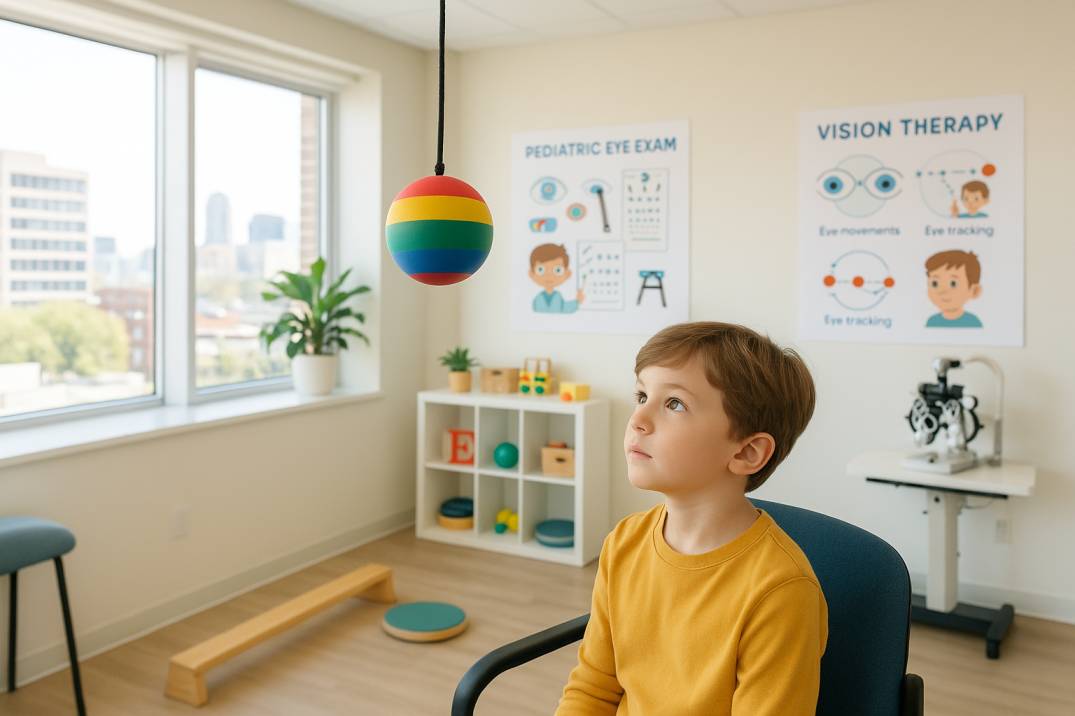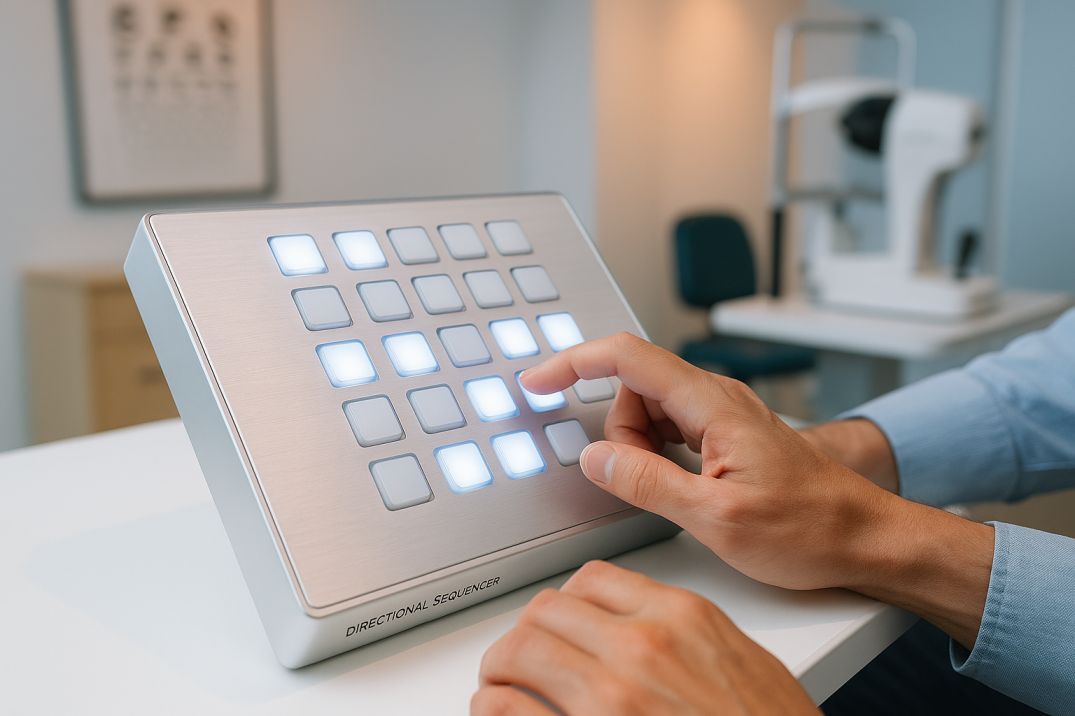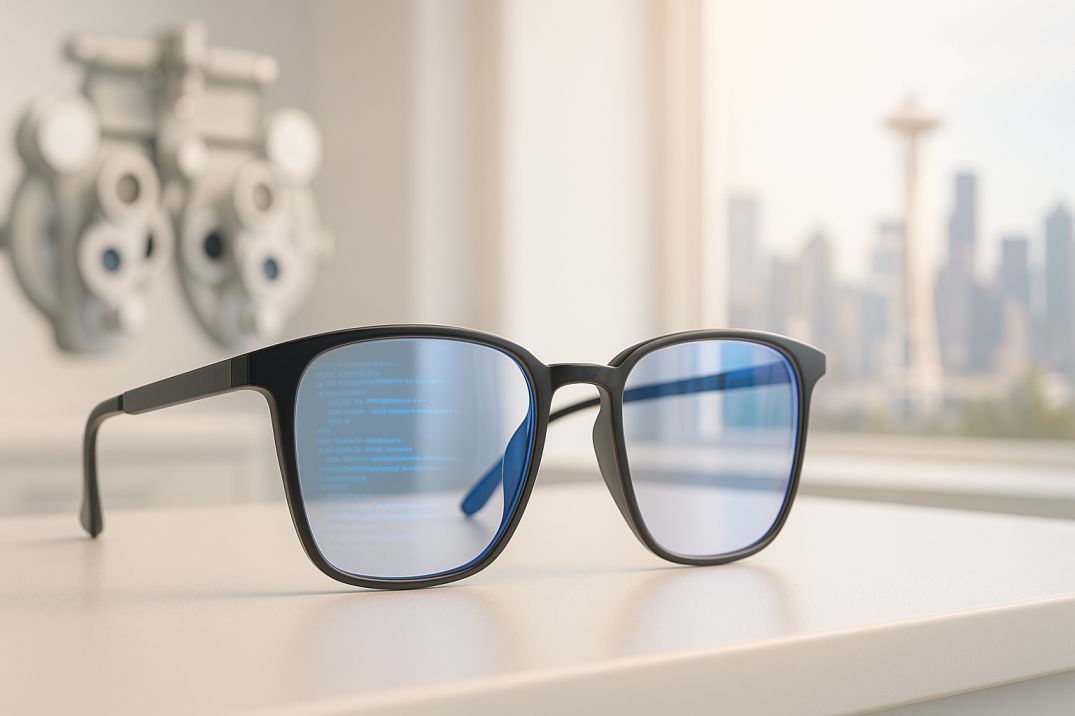Cawthorne-Cooksey Exercises
Struggling with dizziness or balance issues?
Cawthorne-Cooksey exercises offer a proven, step-by-step approach to retrain your brain and restore stability—naturally, safely, and effectively.
Key Takeaways: Cawthorne-Cooksey Exercises for Vestibular Recovery
-
Cawthorne-Cooksey exercises retrain your brain to manage balance by using visual and body cues when the inner ear is compromised, promoting vestibular compensation.
-
The program progresses through 3 levels—starting with eye/head movements in bed, then seated coordination, and finally standing/walking drills—ensuring safety and effectiveness at every stage.
-
Conditions like BPPV, vestibular neuritis, concussion, MS, and age-related imbalance show measurable improvement with consistent exercise, especially under clinical guidance.
-
Improvement typically begins within 2–4 weeks, with major gains seen by 8 weeks of regular, twice-daily sessions, though chronic cases may need longer timelines.
-
Proper technique is critical: Use slow, controlled movements, maintain regular breathing, and avoid overgripping supports.
-
Avoid common mistakes such as advancing levels too soon, skipping sessions, or stopping when symptoms first ease. Recovery requires persistence beyond symptom relief.
-
Always prioritize safety: Stop immediately if you experience severe nausea, chest pain, fainting, or neurological symptoms. Mild dizziness and fatigue are normal early on.
-
Cannon EyeCare in Seattle emphasizes individualized progression, clinician-approved transitions between levels, and a structured recovery approach tailored to each patient’s condition.
Understanding Cawthorne-Cooksey Exercises: Your Path to Better Balance
Cawthorne-Cooksey exercises are a proven series of targeted head, eye, and body movements designed to activate vestibular compensation – your brain’s natural ability to adapt after inner ear damage. By practicing these exercises regularly, patients retrain their central nervous system to prioritize visual and body-position cues when vestibular signals falter, effectively reducing dizziness and improving stability.
Why Your Vestibular System Matters
Nestled within your inner ear, the vestibular system includes delicate structures:
-
Three fluid-filled semicircular canals (tracking head rotation)
-
Two otolith organs (sensing gravity and linear motion)
When injury, infection, aging, or disease disrupts this system, conflicting signals trigger vertigo, imbalance, and nausea.
The Science Behind the Success
These exercises work through central compensation – a neuroplasticity process where your brain builds new neural pathways. By progressively challenging your balance in controlled stages, Cawthorne-Cooksey stimulates this adaptation:
-
Starting simple to rebuild confidence
-
Increasing complexity safely
-
Promoting lasting functional improvements
The 3-Level Progression System
Cawthorne-Cooksey’s tiered approach ensures safe, effective vestibular rehabilitation at Cannon EyeCare in Seattle:
- Level 1: Seated/Lying Foundations
Gentle eye and head movements to recalibrate sensory input - Level 2: Seated Coordination
Incorporating torso movements and focused gaze stability - Level 3: Dynamic Balance Training
Standing/walking activities mimicking real-world challenges
Who Benefits from Cawthorne-Cooksey Exercises? Insights from Seattle’s Experts
At Cannon EyeCare in Seattle, we use evidence-based Cawthorne-Cooksey exercises to help patients overcome vestibular disorders. Research confirms their effectiveness for these key conditions:
Primary Conditions We Treat
1. Benign Paroxysmal Positional Vertigo (BPPV)
-
Affects 2.4% of adults yearly (the most common cause)
-
Triggers brief spinning sensations during head movements
-
How exercises help: Retrain your brain to resolve conflicting balance signals
2. Vestibular Neuritis & Labyrinthitis
-
Inner ear inflammation often follows viral infections
-
How exercises help: Accelerate natural compensation for dizziness and imbalance
-
Persistent balance issues after traumatic brain injury
-
How exercises help: Restore neural pathways through structured rehabilitation
4. Multiple Sclerosis (MS)
-
Impacts stability in 85% of MS patients
-
How exercises help: Reduce fall risk and improve daily mobility
5. Age-Related Balance Decline
-
Natural vestibular weakening in older adults
-
How exercises help: Strengthen sensory integration to prevent falls
Level 1 Cawthorne-Cooksey Exercises: Bed & Chair Foundations
Start your vestibular rehabilitation safely with Level 1 exercises from Cannon EyeCare in Seattle. Designed for patients with severe dizziness or limited mobility, these bed or chair-based movements rebuild neural pathways through systematic repetition.
Eye Movement Exercises
Perform 5-10 repetitions each, head stationary:
-
Horizontal Tracking
-
Look slowly right → left
-
Focus on a fixed target (like your finger)
-
Gradually increase speed as tolerated
-
-
Vertical Tracking
-
Look slowly up → down
-
Maintain steady head position
-
Control the movement rhythm
-
-
Diagonal Patterns
-
Look up-right → down-left
-
Reverse: up-left → down-right
-
Keep motions smooth and precise
-
Head Movement Exercises
Perform 5-10 reps each. STOP if severe nausea/imbalance occurs:
-
Head Turns
-
Slowly rotate head right → left
-
Eyes focused straight ahead
-
Increase speed gradually
-
-
Head Nods
-
Nod up → down slowly
-
Maintain visual focus on a stationary object
-
Progress to faster motions
-
-
Head Tilts
-
Tilt ear toward right shoulder → left shoulder
-
Keep shoulders relaxed/level
-
Hold 1-2 seconds per side
-
Treatment Protocol at Cannon EyeCare
-
Frequency: Twice daily (morning/evening)
-
Duration: Begin with 5-10 minute sessions
-
Progression:
-
Rest 30-60 seconds between exercises
-
Increase reps as symptoms improve
-
Advance to Level 2 only with clinician approval
-
Level 2 Cawthorne-Cooksey Exercises: Seated Progression
After mastering Level 1 with minimal dizziness, advance to these seated activities at Cannon EyeCare in Seattle. Level 2 safely challenges your vestibular system with coordinated movements while reducing fall risks.
Key Coordination Exercises
Perform seated with stable posture:
-
Shoulder Mobility
-
Roll shoulders forward/backward (10 reps each)
-
Shrug shoulders up/down slowly
-
Add challenge: Combine with gentle head turns
-
-
Object Retrieval Practice
-
Place objects (e.g., small weights) beside the chair
-
Pick up items while maintaining an upright posture
-
Alternate sides to engage different neural pathways
-
-
-
Hold a finger 18 inches from your face
-
Track moving finger horizontally with eyes AND head
-
Reverse drill: Move head while locking eyes on a stationary target
-
Progressing to Level 3
Only advance when you can:
- Complete all exercises without significant dizziness
- Maintain balance during object retrieval
- Perform full 10-minute sessions without rests
(Always consult your Seattle vestibular therapist before progression)
Level 3 Cawthorne-Cooksey Exercises: Dynamic Balance Mastery
Level 3 marks the functional peak of vestibular rehabilitation at Cannon EyeCare in Seattle. These standing and walking exercises simulate real-world challenges—only begin after confidently completing Levels 1 and 2.
Critical Safety Precautions
-
Always position yourself near a wall or sturdy surface
-
Have a support person present during initial attempts
-
Immediately stop if unsteadiness or nausea occurs
Standing Balance Drills
Perform near support:
-
Static Standing
-
Stand feet shoulder-width apart
-
Progress from eyes open → eyes closed → single-leg stance
-
-
Weight Shifting
-
Shift side-to-side, then forward-backward
-
Advance to controlled circular shifts
-
-
Ball Tossing Coordination
-
Toss/catch a ball against the wall
-
Begin with slow, large throws → advance to quick, small throws
-
Dynamic Walking Activities
-
Walking with Head Movements
-
Walk straight while turning your head side-to-side
-
Walk while looking up/down
-
Practice reading signs/numbers while walking
-
-
Tandem Walking
-
Walk heel-to-toe in a straight line
-
Start with arms for balance → progress to arms crossed
-
Progression Guidance
Advance only when you can:
-
Complete all drills without dizziness
-
Maintain stability during ball tosses and tandem walking
-
Perform 15-minute sessions safely
Recovery Timeline: When to Expect Results from Cawthorne-Cooksey Exercises
At Cannon EyeCare in Seattle, we understand patients’ urgency to know: How soon will these exercises work? While individual results vary, 2024 clinical studies show most achieve significant improvement within 8 weeks of consistent practice. Here’s what to expect:
Typical Recovery Phases
Weeks 1-2: Adaptation
-
Focus on symptom management and technique mastery
-
Temporary dizziness increase is normal (your brain is adjusting)
Weeks 3-4: Early Gains
-
Reduced vertigo intensity
-
Improved exercise tolerance
-
Growing balance confidence
Weeks 5-8: Major Progress
-
Fewer dizziness episodes
-
Enhanced functional balance
-
Gradual return to daily activities
Weeks 9-12: Optimization
-
Refined balance responses
-
Long-term maintenance strategies
-
Full activity resumption
Key Factors Influencing Your Timeline
Condition-Specific Variables
-
BPPV: Often improves in 2-4 weeks
-
Vestibular Neuritis: Typically requires 6-12 weeks
-
Chronic Conditions: May need extended rehabilitation
Individual Factors
-
Age (younger patients often progress faster)
-
Overall health and fitness level
-
Strict adherence to exercise protocols
-
Initial symptom severity
Avoid These Common Mistakes: Expert Tips from Seattle’s Vestibular Clinic
At Cannon EyeCare, we’ve identified frequent errors that delay Seattle patients’ progress with Cawthorne-Cooksey exercises. Avoid these pitfalls to maximize your recovery:
Critical Exercise Technique Errors
-
Rushing Progression
Mistake: Advancing levels too quickly
Solution: Master each level fully (minimum 1-2 weeks per stage) -
Inconsistent Practice
Mistake: Irregular exercise sessions
Solution: Schedule twice-daily sessions + use phone reminders -
Premature Discontinuation
Mistake: Stopping when symptoms ease
Solution: Continue exercises 2-4 weeks post-symptom resolution
Safety & Form Corrections
-
Problematic Habits
-
Jerky/uncontrolled motions
-
Breath-holding during movements
-
White-knuckle grip on supports
-
-
Proper Technique
-
Smooth, deliberate movements
-
Maintain normal breathing
-
Light fingertip touch for balance only
-
Safety First: When to Pause or Seek Help During Vestibular Exercises
At Cannon EyeCare in Seattle, your safety drives our care. While Cawthorne-Cooksey exercises are low-risk, recognizing warning signs ensures secure rehabilitation.
Normal vs. Concerning Symptoms
Continue with caution if experiencing:
-
Mild dizziness or lightheadedness
-
Brief nausea
-
Slight fatigue
-
Temporary unsteadiness
STOP IMMEDIATELY and contact your provider for:
-
Severe nausea/vomiting
-
Chest pain or shortness of breath
-
Loss of consciousness/near-fainting
-
Sudden severe headache
-
Numbness or weakness
Pre-Session Safety Checklist
Before exercising:
- Clear obstacles from the movement area
- Position the wall or sturdy support within reach
- Wear non-slip footwear
- Ensure adequate lighting
- Notify someone of your session time
Cawthorne-Cooksey exercises provide a structured, evidence-based path to regain balance, reduce dizziness, and reclaim confidence in your daily life. Whether you’re recovering from BPPV, a concussion, or age-related vestibular decline, consistent practice guided by professionals can lead to lasting improvements.
Ready to take the next step toward better balance?
Schedule a personalized vestibular assessment at Cannon EyeCare in Seattle today—and let our experts guide your recovery journey with care and precision.
FAQs
-
Most people see improvement within 2-8 weeks with daily practice. Significant balance gains typically occur within 8 weeks of consistent exercise




